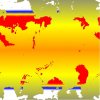Firstly, i checked out DF geological layers here. I must admit that the guys have done marvelous job and that it's not TOO difficult to get things rolling - although i haven't looked at any other "more into depth" documentation on it. Basically, as far as i've understood, they've split the heightmap into five layers, e.g. top 20% is soil, next 20% is sedimentary layer etc. Then they use some noise function to distribute the minerals to appropriate layers and a fractal function to form mineral veins. No geological data or complex physics simulations involved what so ever - but, the chances are that i'm greatly wrong here. Please educate me on this topic! 
While researching i also gave a few thoughts on how to utilize the history of the crust generated by the plate tectonic process. I found a really nice picture of North America that shows the age and type of rocks in the continent. PlaTec simulator currently tracks the age of the crust (only on the x,y plane) and this value could be used to determine 1) where volcanically active plate edges (have) reside(d) 2) where volcanoes (have) reside(d) 3) the amount of volcanic activity that a point (x, y) on the map has experienced during its existence. This data could help tremendously in deciding what kind of stone/minerals a point (x,y) on the map most probably might contain.
While researching i also gave a few thoughts on how to utilize the history of the crust generated by the plate tectonic process. I found a really nice picture of North America that shows the age and type of rocks in the continent. PlaTec simulator currently tracks the age of the crust (only on the x,y plane) and this value could be used to determine 1) where volcanically active plate edges (have) reside(d) 2) where volcanoes (have) reside(d) 3) the amount of volcanic activity that a point (x, y) on the map has experienced during its existence. This data could help tremendously in deciding what kind of stone/minerals a point (x,y) on the map most probably might contain.







